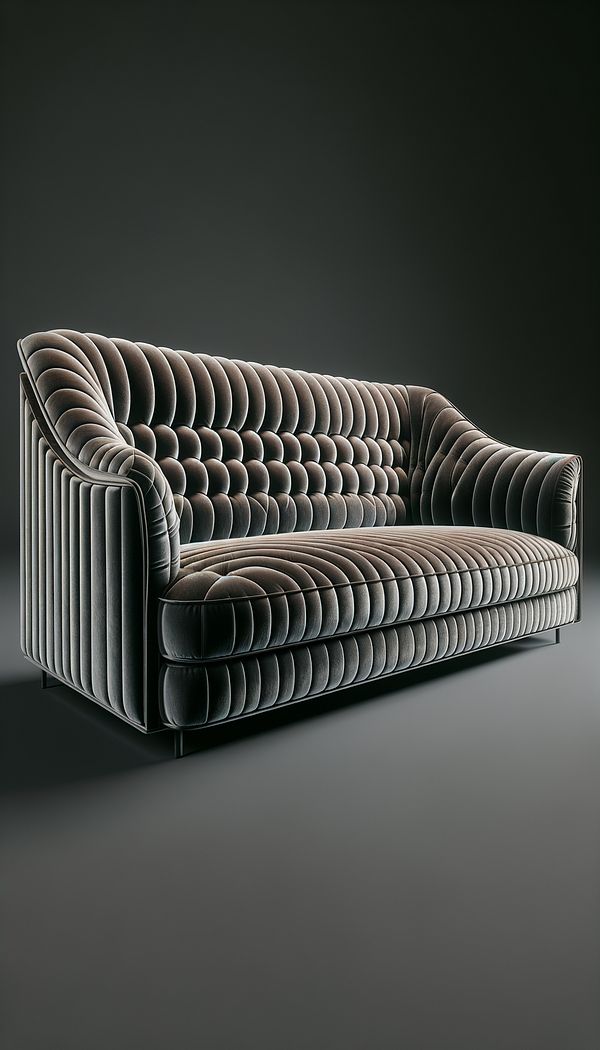What is Channeling?
Channeling is a distinctive decorative technique used in upholstery and furniture design.
Description
Channeling refers to a series of parallel lines created by narrow folds of fabric or leather, padded with foam or batting, and sewn at regular intervals to create a textured, paneled effect. This technique adds both visual appeal and a tactile dimension to the surface of upholstered furniture, making it a popular choice for adding sophistication and depth to pieces like sofas, chairs, and headboards.
The unique raised pattern formed through channeling not only enhances the aesthetics of a piece but also contributes to its comfort and durability. By creating structured segments within the piece, channeling can help distribute wear and tear more evenly across the surface, extending the furniture's lifespan. The method can be applied using a variety of materials, including velvet, leather, and other upholstery fabrics, allowing for flexibility in design according to the desired final look.
Over the years, channeling has become synonymous with luxury and elegance in interior design. Its usage spans quite broadly, from modern minimalist designs to more elaborate and traditionally styled interiors. Furthermore, channeling can be customized in terms of the width and depth of the channels, offering designers and homeowners the opportunity to create truly personalized pieces that fit their specific aesthetic and functional needs.
Usage
Channeling is commonly seen in high-end furniture collections, luxury vehicle interiors, and bespoke interior design projects. Its visual impact is best appreciated in seating areas where the texture and pattern can be both seen and felt, such as in tufted leather sofas in a luxury lounge or velvet channeled headboards in boutique hotel suites. It is also frequently used in the interiors of high-end vehicles, adding an extra layer of opulence and comfort.
FAQs
-
How does channeling affect the comfort of furniture?
Channeling enhances furniture comfort by creating a series of padded, structured segments. This provides additional cushioning and supports evenly distributed pressure relief for users.
-
Is channeling suitable for all types of furniture?
While channeling can be used on various furniture types, it is particularly effective on pieces with large, flat surfaces like sofas, headboards, and ottomans where the decorative technique can be fully showcased.
-
Can channeling be applied to any upholstery material?
Channeling works best with softer, more pliable materials such as velvet, leather, or thick textiles that can be easily shaped and padded. Stiffer fabrics may not achieve the desired textured effect.
-
Does channeling require professional application?
Given its intricate nature, professional skills are recommended for applying channeling to ensure precision and durability. However, with the right tools and some practice, DIY enthusiasts may attempt simpler projects.
-
How does channeling integrate with different interior design styles?
Channeling is versatile and can complement various design styles, from modern and minimalist to traditional and luxurious. Its application can be customized to suit the overall aesthetic of a room by altering the material, color, and spacing of the channels.
Practical Application
When considering incorporating channeling into your furniture design or upholstery project, it's important to keep a few factors in mind:
1. Material selection is crucial; choose a fabric that complements the desired effect, ensuring it is soft and pliable enough to create even, attractive channels.
2. Decide on the channel width and spacing according to the scale of the piece—larger pieces may benefit from wider channels to maintain proportionality.
3. Consult with a professional upholsterer or interior designer to ensure precision in the channeling process, especially for more complex or high-stakes projects.
4. Use channeling to not just add visual appeal but also to enhance the comfort and longevity of the furniture piece.
-
Tailored UpholsteryTailored upholstery refers to furniture coverings that are custom-fitted and meticulously crafted for a neat, polished appearance.
-
BaggingBagging is a decorative wall finish obtained by applying a thin cement-based layer to walls and then manipulating it with a sponge or cloth.
-
Farthingale ChairA Farthingale Chair is a type of chair with a wide seat and usually no armrests, designed to accommodate the wide skirts of women's dresses in the 16th to 17th centuries.
-
Tight-Back SofaA tight-back sofa is a type of couch that has a fully upholstered back without any loose cushions.
-
EmbossedEmbossed refers to a surface decorated with a raised or recessed design.
